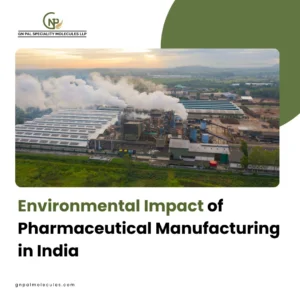Introduction
India is commonly referred to as the “pharmacy of the world,” and for good reason—it has the third-largest pharmaceutical industry in the world by volume and is among the world’s largest generic drug exporters. But what lies hidden behind this economic achievement is a highly disconcerting environmental truth. Pharmaceutical production and india api manufacturing has boomed so rapidly that it has come at an enormous environmental price. From rivers choked with chemical residues to aethers filled with industrial effluent, the toll of unregulated pharmaceutical manufacture is increasing rapidly.
The problem is not restricted to scattered areas of the nation. Major pharma centers such as Hyderabad, Baddi, and Ankleshwar are havens of pollution, affecting the environment as well as human and animal health. The common water body pollution, the development of antimicrobial resistance, and damage to ecosystems are only a few of the consequences of this industry boom.
The irony is bitter—the same industry that assists in healing diseases is adding to the environmental degradation that goes on to produce new health hazards. Therefore, while we are dependent on India’s pharma strength for getting low-cost drugs to millions of people across the globe, we also need to address the dark underside of its environmental impact.
Comprehending the environmental cost of pharma production in India isn’t only a scientific issue; it’s a socio-political imperative. As we delve into the extent of this problem, we’ll delve into how the expansion of this industry, paired with lax enforcement of environmental law, has created a poisonous heritage—and how to reverse it.
Emergence of the Pharmaceutical Industry in India
India’s pharma industry has grown exponentially over the last few decades. What was a fairly small industry in the post-independence period has now grown to become a global giant. India has over 3,000 drug firms and about 10,500 manufacturing facilities and makes over 60,000 generic brands in 60 therapeutic categories.
The expansion has been spurred by a range of factors: favorable government policy, skilled labor force, cheap production, and surging demand for cheap medicine both regionally and globally. Export sales constitute over 50% of the sector’s production, with major markets being the U.S., Europe, Africa, and Latin America.
Pharmaceutical hubs like Hyderabad, also called “Genome Valley,” are representative of this development. Such places abound in industrial complexes with hundreds of production units within them. But with such a scale of production comes the maximum amount of environmental strain. In order to fulfill high international demand, several of these units work day and night, thereby raising the amount of waste and emissions generated.
Inevitably, however, the emphasis on economic growth has tended to come at the expense of environmental concerns. Financing for environmentally friendly technologies and pollution treatment plants hasn’t kept up with the industry’s rapid development. Smaller facilities especially tend not to have the budgets—or the inclination—to institute effective pollution control measures.
While the sector is a vital component of India’s economic machinery, producing billions of dollars and employing millions, its uncontrolled expansion has started pushing environmental resilience in priority production regions to the limit. Finding a balance between profit and safeguarding the environment is not only necessary—it’s imperative.
Serious Environmental Issues Presented by Pharmaceutical Production
The drug production process is naturally cumbersome and resource dependent. It requires the application of an extensive variety of chemicals, solvents, and biological substances. Therefore, the environmental problems created by the industry are multi-faceted in nature and harm water, air, and land at once.
Water Pollution and Contamination
The most critical problem is water pollution. Waste effluents released from pharma plants commonly contain active pharmaceutical ingredients (APIs), heavy metals, solvents, and other toxic chemicals. When these are not properly treated, they flow into rivers, lakes, and groundwater systems, having severe implications for aquatic life and human health.
Air Emissions from Production Plants
Air pollution is also a significant issue. Industries emit volatile organic compounds (VOCs), particulate matter, and other poisonous gases as by-products of their manufacturing processes. Not only do these emissions worsen air quality but they may also cause respiratory illnesses in local residents.
Hazardous Waste and Improper Disposal
Pharma production produces considerable quantities of solid and toxic waste, such as expired chemicals, packaging material, and chemical reaction waste products. If improperly disposed of through open dumping, unauthorized burning, or unlined landfills, such materials can contaminate soil, long-term environmental damage.
These difficulties are usually compounded by the absence of tough enforcement measures. Even where regulations are in place, they are usually disregarded or poorly enforced. Small producers will also seek to save costs at the expense of environmental controls, further contributing to the challenge.
Water Pollution due to Pharmaceutical Effluents
Pollution of water is perhaps the most critical environmental problem arising out of pharmaceutical production in India. The untreated or partially treated factory effluents are frequently discharged straight into local water bodies, making rivers chemical soup.
Common Pollutants in Wastewater
The effluents are usually a combination of antibiotics, analgesics, hormones, solvents, and heavy metals. APIs in very high concentrations have been found in most Indian rivers, particularly around industrial clusters. The chemicals do not break down, and they impact not only the aquatic environment but also the communities living off these water bodies for drinking and agriculture.
A study conducted in 2017 discovered extremely high concentrations of ciprofloxacin, a very common antibiotic, in the Patancheru-Bollaram industrial zone near Hyderabad. The concentration was so high that theoretically it could treat thousands of individuals per day, sending strong alarms regarding the magnitude of pollution.
Case Studies of Affected Rivers and Communities
The Telangana Musi River is the most glaring instance of pharmaceutical water pollution. What was once a drinking water source is now a poisonous drain filled with industrial and pharmaceutical waste. Local residents have seen more instances of skin ailments, gastrointestinal illness, and even birth deformities due to exposure.
Residents near Baddi in Himachal Pradesh have also reported stinking water, lowered agricultural yields, and fish death in nearby streams. These instances are not isolated—they present a grim picture of pharma waste ruining precious water resources across the nation.
The cumulative impact of this pollution is massive. It affects biodiversity, public health, and even economic activities like farming and fishing. Worse, it lays the foundation for more complex health problems, including antimicrobial resistance, which we’ll explore in the next section.
Antimicrobial Resistance (AMR) and Pharmaceutical Waste
Antimicrobial Resistance (AMR) is a time bomb—and pharmaceutical waste is among the key drivers propelling this worldwide health threat. Pharmaceutical companies’ overuse and indiscriminate discharge of antibiotics in India have initiated the development of drug-resistant bacteria in the environment.
How Pharmaceutical Discharge Promotes AMR
When antibiotic-laden effluents find their way into water bodies, they provide perfect breeding sites for resistant microorganisms. These microbials develop to thrive in poisonous environments and are able to pass on their resistant genes to other microbes. This eventually results in infections in animals and human beings that are impossible—or at least extremely hard—to treat using standard antibiotics.
India is already among the most AMR-affected countries, with resistant E. coli, Klebsiella, and even tuberculosis bacteria found by studies. Bacteria resistant to a range of antibiotics have been found in pharma cluster surrounds, and these have been described as resistance evolution hotspots.
Global Implications of AMR Originating in India
The increase of AMR isn’t only India’s issue—it’s an international crisis. Bacteria that are resistant can be transmitted via water, food, animals, and human movement across borders without any difficulty. Because India is a large exporter of drugs, sloppy controls and inadequate waste disposal here might have global impacts.
Global health agencies such as the WHO and UN have constantly cautioned against the relationship between drug pollution and AMR. Disregarding this danger may reverse decades of medical gains, driving humanity into a post-antibiotic age where infections become life-threatening.
Types of Emissions from Pharma Factories
Pharmaceutical production consists of several chemical operations, some of which release volatile organic compounds (VOCs), particulate matter (PM), and dangerous gases like nitrogen oxides (NOx), sulfur dioxide (SO₂), and carbon monoxide (CO). These emissions come from several processes such as chemical synthesis, solvent recovery, combustion steps, and drying equipment.
Secondly, some pharmaceutical intermediates emit powerful odors and irritants. They may be acidic or basic in nature and present severe discomfiture and respiratory problems. At production times of peak intensity, the emission gets extremely intense, dominating the surrounding atmosphere.
In the majority of the small to mid-sized pharma units, the air pollution control equipment like scrubbers and filters are obsolete or inoperative. Even in large factories, the loopholes in regulations ensure that the emissions continue to rise above permissible limits without much penalty.
Impact on Local Air Quality and Health
The immediate effect of these unregulated emissions is bad air quality around and within pharma clusters. Locals residing close to pharma clusters such as Hyderabad’s Patancheru, Ankleshwar in Gujarat, and Himachal Pradesh’s Baddi suffer from persistent respiratory ailments like asthma, bronchitis, and migraines.
Prolonged exposure to these toxins may result in chronic health problems such as cardiovascular conditions, lung cancer, and neurological diseases. Vulnerable groups such as children and the elderly are most at risk, as their immune systems are underdeveloped or compromised.
More disturbing, however, is the absence of live air monitoring in most industrial areas. Without proper information, it becomes almost impossible to gauge the complete depth of the damage or appeal for rectification. The lack of openness makes populations powerless in tackling the pharma industry-caused air pollution.
Types of Hazardous Waste Generated
The categories of solid and hazardous waste produced depend on the size and nature of the pharmaceutical operations. They include:
- Chemical waste: Byproducts of reactions, acids, alkalis, and residual solvents.
- Biological waste: Microbial biomass, culture media, and infected waste.
- Packaging waste: Infected plastic, metal, and glass containers.
- Outdated or rejected drugs: These are usually active compounds that can last in the environment.
- Sludge from ETPs: It is usually toxic and requires to be treated with utmost care.
As per Central Pollution Control Board (CPCB) data, pharmaceutical units account for a considerable share of India’s hazardous waste burden. However, adherence to Hazardous Waste Management Rules is reasonably low.
Incineration and Landfill Problems
The conventional ways of getting rid of pharma hazardous waste are incineration and landfilling. Both, however, have serious problems. Incineration, if improperly carried out at the incorrect temperature or without adequate controls, can emit dioxins and furans—highly toxic substances injurious to humans and the environment.
Landfilling, however, is prone to leaching. Leachate from toxic substances seeps into the ground and taints groundwater, impacting agriculture and drinking water sources. Most of the unregulated or informal landfills throughout India are not properly operated, with no liner or leachate collection system.
Making matters worse, waste disposal is usually contracted out to outside companies, some of which take shortcuts in order to make the most money. The result is illegal dumping in forests, rivers, and open fields—making pharmaceutical waste a neighborhood health risk.
Impact on Biodiversity and Local Ecosystems
The eco-footprint of pharmaceutical production goes beyond human health to touch the issue of biodiversity. The discharge of pharmaceutical pollutants into air, water, and soil contaminates and alters local ecosystems and threatens plant and animal species crucial to ecological equilibrium.
Pharmaceutical Residues in Soil and Water
When pharma effluents or solid waste are introduced into the environment, they change the chemical makeup of the water bodies and soil. For instance, antibiotics in water bodies will suppress the activity of beneficial microbes that are involved in the cycling of nutrients and decomposition of wastes.
In the soil, residues of hormonal pharmaceuticals, heavy metals, and persistent organic pollutants lower fertility and hurt the natural balance of microorganisms. It has an impact on crop yields and can cause bioaccumulation—where poisonous products accumulate in plants and find their way into the food chain.
These residues are particularly harmful since they do not readily degrade. In contrast to some organic waste, pharmaceutical contaminants can last in the environment for decades, thereby creating the likelihood of long-term exposure in polluted environments nearly unavoidable.
Effects on Flora and Fauna
The availability of pharmaceutical residues has a ruinous impact on aquatic organisms. Research indicates that fish that are subjected to trace antibiotics and hormones show behavioral changes, reproductive challenges, and even genetic mutations. Insect populations—pollinators such as bees—are also susceptible, causing a ripple effect on the food chain.
Wild animals, particularly those consuming water from polluted water sources, are affected by chronic poisoning. Cattle and dogs have been reported to be affected by kidney and liver injury from drinking water in the vicinity of pharma units.
One of the most poignant examples is the almost extermination of vultures in India. Veterinary medicines such as diclofenac found their way into the environment via cattle carcasses, killing millions of the birds and impeding natural scavenging functions—resulting in an increase in feral dogs and related diseases such as rabies.
Role of CPCB and State Pollution Control Boards
The Central Pollution Control Board (CPCB) is the top-most authority that determines pollution control norms. Below it, every state has a State Pollution Control Board (SPCB) that is mandated to oversee, inspect, and implement environmental laws at the local level.
The most important regulations are:
- The Water (Prevention and Control of Pollution) Act, 1974
- The Air (Prevention and Control of Pollution) Act, 1981
- The Environment Protection Act, 1986
- Hazardous Waste Management Rules, 2016
- Biomedical Waste Management Rules, 2016
But implementation is usually lacking. SPCBs tend to be understaffed and under-financed and at times beholden to industrial lobbies. Inspection is infrequent and often pre-announced and gives industries time to hide irregularities.
Legal Provisions and Gaps in Enforcement
Though environmental clearances and compliance certificates are necessary for establishing a pharmaceutical manufacturing unit, monitoring is weak once the process is established. In most instances, firms function without effective consents, or with out-of-date environmental management systems.
Legal loopholes also enable companies to circumvent norms by being registered as “small-scale” units, which come under less scrutiny. Fines against violations are also usually too low to be effective deterrents. Public Interest Litigations (PILs) and judicial intervention are sometimes the only ones that could effectively compel accountability.
To actually create an impact, India requires an enhanced, more transparent regulation system with real-time tracking, increased punishments, and involvement of people in monitoring.
Corporate Environmental Responsibility (CER) in Pharma Sector
Corporate Environmental Responsibility (CER) is a corporate obligation to conduct business in a sustainable manner and reduce its footprint on the environment. In India, though some pharma companies have gone some distance in this regard, the majority do not take CER very seriously and consider it just a tick-in-the-box exercise.
Green Manufacturing Initiatives
A few progressive companies have started embracing green manufacturing techniques like:
- Liquid Discharge (ZLD) systems so that there is no untreated effluent released.
- solvent-based closed-loop production systems that generate minimal waste.
- renewable energy sources such as wind and sun to drive factories.
- investments to create sustainable formulations and processes.
Companies such as Cipla, Dr. Reddy’s Laboratories, and Biocon have made their sustainability efforts public and issue periodic environmental reports. These organizations demonstrate how profitability and responsibility can go hand in hand.
Role of Multinational Companies Operating in India
Multinational drug firms having operations in India tend to receive stronger supervision from their home nations and shareholders. Consequently, they keep stricter environmental regulations. Nevertheless, there is also proof that some of them shift the dirty processes to their Indian allies, taking advantage of weaker enforcement systems.
True change will arrive when every pharmaceutical firm, both domestic and international, sees environmental responsibility as anything but PR, but as central to doing business. This means open reporting, third-party audits, and accountability to the communities they touch.
Effluent Treatment Plants (ETPs) and Zero Liquid Discharge (ZLD)
Effluent Treatment Plants (ETPs) are among the most critical technologies for preventing water pollution. These plants are specially designed to extract chemical pollutants, toxins, and biological contaminants from industrial wastewater before discharge into the environment. Most small and medium-sized pharma units either don’t have ETPs or use inefficient and old systems.
Zero Liquid Discharge (ZLD) takes the concept one step further. This cutting-edge system makes it a point that not a single drop of liquid waste is released from the plant. All the water is treated, recaptured, and reused at the plant instead. Though ZLD is compulsory in certain industrial areas of India, it is still patchy because of the huge capital outlay involved.
But those businesses that have implemented ZLD have been able to achieve both environmental and operational advantages in the long term. In addition to regulatory compliance, these technologies can decrease water use and minimize reliance on local water resources.
Implementation of Cleaner Production Methods
Cleaner production (CP) aims to minimize waste and emissions at the source instead of treating it later. A few examples are:
- Applying green chemistry to eliminate or minimize dangerous substances.
- Improving reaction conditions to maximize yield and reduce waste.
- Reusing and recovering solvents rather than eliminating them.
- Using energy-saving equipment and processes.
Other companies are also experimenting with biocatalysis, a process that employs natural enzymes rather than toxic chemicals, so the production process is safer and more environmentally friendly.
As much as the transition to clean production is yet in its early stages in India, it’s pharma manufacturing’s future in sustainability. With increased awareness, government incentives and pressure from the international market, companies will be nudged towards innovation.
Hyderabad Pharma Cluster Incidents
The Hyderabad industrial belt, particularly the localities of Patancheru and Bollaram, has been synonymous with environmental lapses for decades. Such studies have indicated that rivers in this region are polluted with high levels of antibiotics such as ciprofloxacin and ofloxacin, resulting in the formation of antibiotic-resistant bacteria.
Local residents for years have complained of stinky air, discoloration of water, and ailments from respiratory disease to skin disease. Despite repeated notices and even closure orders by the Telangana State Pollution Control Board, most factories remained in operation flouting norms.
This region has been the focus of several global investigations, such as that by the Swedish NGO Health Care Without Harm, which revealed the worldwide implications of Indian pharma centers’ pollution.
Legal Action and Public Response
In some instances, courts have been compelled to intervene. The National Green Tribunal (NGT) has fined pharmaceutical firms for violating environmental standards. In some instances, it has directed payment of compensation to affected communities and ordered environmental cleanup.
Public Interest Litigations (PILs) initiated by NGOs and local communities have been important in bringing pressure for accountability. Media reporting has also raised the voice of affected individuals, generating national and international concerns over the issue.
These case studies are not one-off events—they are indicative of system failures in regulation, enforcement, and company responsibility. They are also a wake-up call to tighten the framework and guarantee that pharmaceutical expansion does not compromise public health and the environment.
Activism and Community Engagement
Such NGOs as Centre for Science and Environment (CSE), Health Care Without Harm, and Public Health Foundation of India (PHFI) have carried out independent research, raised awareness, and launched campaigns to push companies and governments to action.
Such groups tend to partner with local residents’ organizations in order to record evidence of pollution, taking water and soil samples, and make pollution control board complaints. Grassroots movements have managed to stop illicit discharges as well as compel factories to fit more efficient pollution-control devices in various regions.
Public outreach is also important. The social media sites have become means for whistleblowers and activists to disclose abuses. Petitions, street demonstrations, and local media reports have brought needed focus to areas that otherwise would have gone unnoticed.
Media Exposure and Impact
Investigative journalism has revealed a series of top pharma pollution scandals. Stories by global media such as The New York Times, BBC, and The Guardian have exposed the connection between Indian pharmaceutical manufacturing and global antibiotic resistance.
These tales have not only instigated debate but also compelled multinational drug firms sourcing products from India to rethink their supply chains. Such pressure is essential in facilitating a market-driven drive toward sustainability.
However, much remains to be accomplished. Public consciousness is still low, particularly in rural regions. Awareness campaigns, workshops, and inclusion of environmental studies in school curriculums can ensure the development of a future generation with the ethos of sustainability over the maximization of short-term economic returns.
Best Practices and International Models
There are several global models to follow. For instance:
- Sweden and Germany enforce rigorous rules around the disposal of pharmaceutical waste and embrace green chemistry for production.
- The Netherlands has an effective take-back scheme for unused drugs, which keeps them out of landfills and waterways.
- China, as a large polluter, has started enforcing more stringent environmental audits and penalties, which has had a quantifiable effect.
Indian pharmaceutical firms can adopt these best practices by investing in sustainability, implementing improved waste management systems, and ensuring transparency over their environmental record.
Government Incentives for Green Pharma
It is the job of the government to play a crucial role. Through tax incentives, low-interest financing, and quick clearances for green projects, it can give green manufacturing an entrepreneurial flavor.
Initiatives such as the Pharma City in Hyderabad, which is touted to be a “sustainable industrial hub,” are in the right direction. These projects must, however, practice what they preach—ensuring economic development along with environmental sustainability.
Public-private partnerships, enforcement of stricter rules, and improved inter-agency coordination are necessary for a cleaner future.
Conclusion
India’s pharma industry is the backbone of its economy and a critical source of low-cost medicine worldwide. But this achievement has come at an environmental price that can be paid no more. From toxic rivers and poisoned skies to the specter of antimicrobial resistance, the environmental footprint of pharmaceutical production is expansive and complex.
The silver lining? Solutions are available. Whether via improved regulation, grassroots action, or green innovation driven by industry itself, India possesses the instruments to sanitize its pharma sector. The clock is ticking, however. Unless we act with speed and concert, the cost to our health, biological diversity, and water security could come to outweigh the benefits.
As stakeholders—and that means all of us, from policymakers and corporations to NGOs and citizens—there’s a role for everyone. Let’s put aside the finger-pointing and take concrete steps towards sustainable pharmaceutical production in India.
FAQs
1. What is the most significant environmental problem resulting from pharmaceutical production in India?
Most significant is water pollution due to untreated or partially treated effluents, followed by air pollution and hazardous waste management.
2. How does pharma waste fuel antimicrobial resistance?
Factory waste contains antibiotics that help resistant bacteria grow in the environment, which can pass resistance to human pathogens—resulting in harder-to-treat infections.
3. What Indian laws control pharmaceutical pollution?
India has a number of laws such as the Environment Protection Act, Water Act, Air Act, and Hazardous Waste Management Rules that are enforced by CPCB and State Pollution Control Boards.
4. Is it possible for pharma industries to be environmentally friendly?
Yes. By adopting technologies such as Zero Liquid Discharge, green chemistry, and proper waste management, pharma units can drastically minimize their environmental impact.
5. What are the steps that consumers can take to lower the impact?
Use medicines responsibly, don’t overuse over-the-counter antibiotics, buy eco-friendly brands, and take part in drug take-back programs where available.






